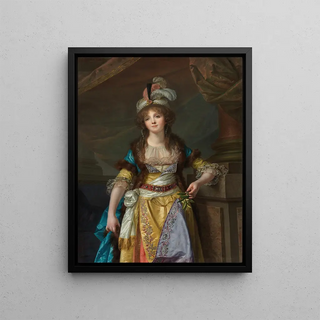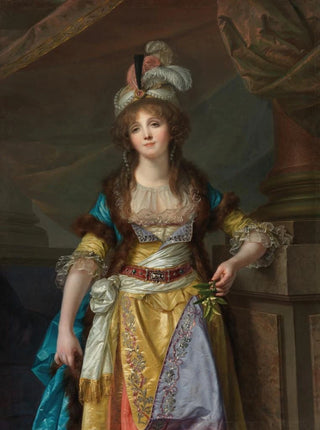Art print | Portrait of a lady in Turkish costume - Jean-Baptiste Greuze


View from behind

Frame (optional)
Portrait of a Lady in Turkish Costume - Jean-Baptiste Greuze – Captivating Introduction
The artwork "Portrait of a Lady in Turkish Costume" by Jean-Baptiste Greuze is a piece that transcends the simple frame of painting to become a true window into history and culture. Created at the end of the 18th century, this work reflects an era when the Orient fascinated the West, giving rise to a rich and colorful aesthetic. The depiction of a woman dressed in Turkish attire, with its luxurious drapery and delicate ornaments, invites the viewer to immerse themselves in an exotic yet refined universe. This piece, beyond its formal beauty, raises questions about identity and cultural perception, while fitting into the artistic movement of its time.
Style and uniqueness of the work
Greuze's style is characterized by a particular attention to detail and an exceptional mastery of light and shadow play. In "Portrait of a Lady in Turkish Costume," every element is carefully crafted, from the folds of the clothing to the expressions on the face. The softness of the woman's features, as well as the brilliance of the colors, evoke an almost tactile sensitivity. The artist manages to capture not only the physical beauty of his model but also a certain psychological depth. The lady's gaze, both gentle and mysterious, seems to tell a story, engaging the viewer in a silent dialogue. This ability to blend realism with an almost dreamlike dimension makes this work a centerpiece of 18th-century portraiture.
The artist and his influence
Jean-Baptiste Greuze, born in 1725, is one of the most emblematic painters of his era. Trained within the academic environment, he stands out for his ability to depict human emotions with rare intensity. His work aligns with the Rococo movement but is distinguished by a more intimate and psychological approach to portraiture. Greuze established himself as a master of the genre, influencing many artists who followed him. His critical view of society and interest in everyday life are reflected in his works, where he depicts scenes from daily life while maintaining a high artistic dimension. The "Portrait of

Matte finish

View from behind

Frame (optional)
Portrait of a Lady in Turkish Costume - Jean-Baptiste Greuze – Captivating Introduction
The artwork "Portrait of a Lady in Turkish Costume" by Jean-Baptiste Greuze is a piece that transcends the simple frame of painting to become a true window into history and culture. Created at the end of the 18th century, this work reflects an era when the Orient fascinated the West, giving rise to a rich and colorful aesthetic. The depiction of a woman dressed in Turkish attire, with its luxurious drapery and delicate ornaments, invites the viewer to immerse themselves in an exotic yet refined universe. This piece, beyond its formal beauty, raises questions about identity and cultural perception, while fitting into the artistic movement of its time.
Style and uniqueness of the work
Greuze's style is characterized by a particular attention to detail and an exceptional mastery of light and shadow play. In "Portrait of a Lady in Turkish Costume," every element is carefully crafted, from the folds of the clothing to the expressions on the face. The softness of the woman's features, as well as the brilliance of the colors, evoke an almost tactile sensitivity. The artist manages to capture not only the physical beauty of his model but also a certain psychological depth. The lady's gaze, both gentle and mysterious, seems to tell a story, engaging the viewer in a silent dialogue. This ability to blend realism with an almost dreamlike dimension makes this work a centerpiece of 18th-century portraiture.
The artist and his influence
Jean-Baptiste Greuze, born in 1725, is one of the most emblematic painters of his era. Trained within the academic environment, he stands out for his ability to depict human emotions with rare intensity. His work aligns with the Rococo movement but is distinguished by a more intimate and psychological approach to portraiture. Greuze established himself as a master of the genre, influencing many artists who followed him. His critical view of society and interest in everyday life are reflected in his works, where he depicts scenes from daily life while maintaining a high artistic dimension. The "Portrait of






